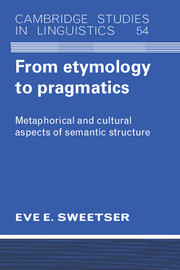Book contents
6 - Retrospect and prospect
Published online by Cambridge University Press: 05 June 2012
Summary
I began this work by offering the reader some examples of apparently puzzling, but common, patterns in historical change of meaning. In the course of chapter 2, certain documented historical trends and synchronic semantic structures were shown to involve a pervasive metaphorical structuring of our internal mental world in terms of our physical world. This structuring is experientially based: our internal self is not objectively “like” our physical self, but our physical and psychological worlds have numerous experiential links drawing them together. Given the concept of structuring one domain in terms of another, the “puzzles” offered at the beginning of chapter 2 were suddenly unmasked as self-evident. No complex unravelling was necessary to explain the link between (for example) way and anyway, or grasp and understand; given the structuring of our whole mental vocabulary, these semantic relationships are naturally motivated by the general framework.
A further positive result of this historical analysis is that it is equally applicable to synchronic polysemy-structures. A unified concept of semantic “relatedness,” in which one frequent kind of relation is metaphor, can account for both synchronic lexical-meaning structure and diachronic directions in semantic change.
There are two theoretical points which need emphasis here. The first is that one cannot automatically expect a synchronic semantic theory to deal naturally with historical change: I have argued that objectivist feature-analysis is inadequate in this respect. The second is that it may be useful for synchronic semantic analysis itself to examine synchrony and diachrony side-by-side. Historical evidence can be a metric for choosing between different synchronic semantic theories.
- Type
- Chapter
- Information
- From Etymology to PragmaticsMetaphorical and Cultural Aspects of Semantic Structure, pp. 145 - 148Publisher: Cambridge University PressPrint publication year: 1990



